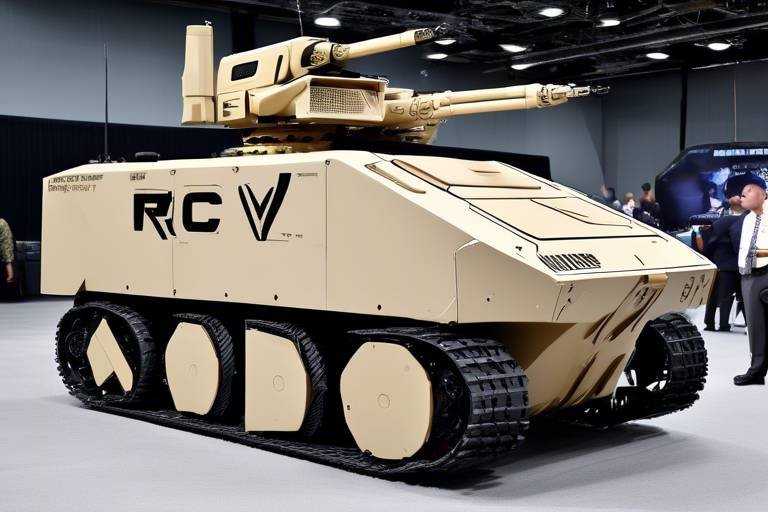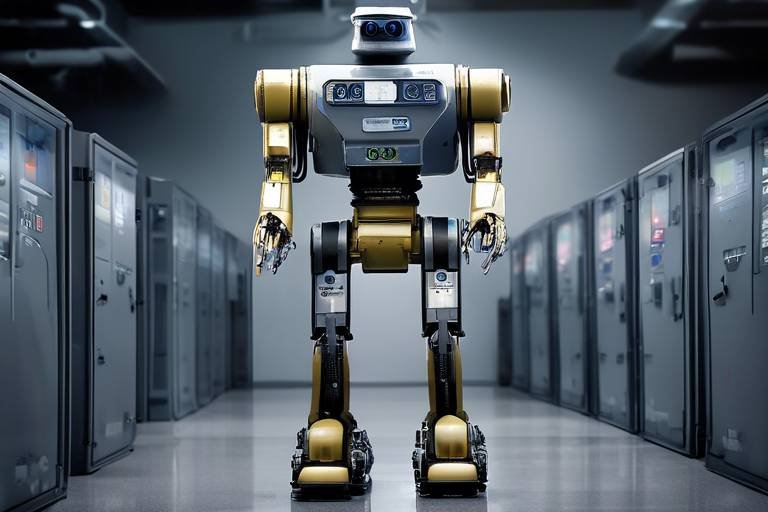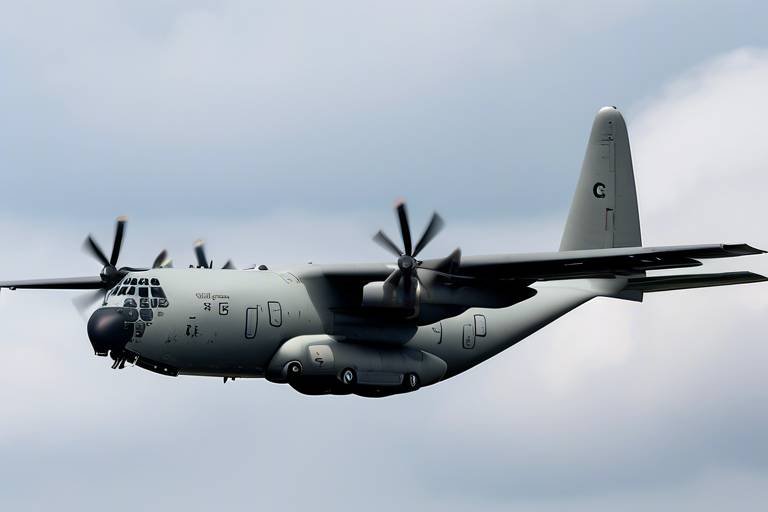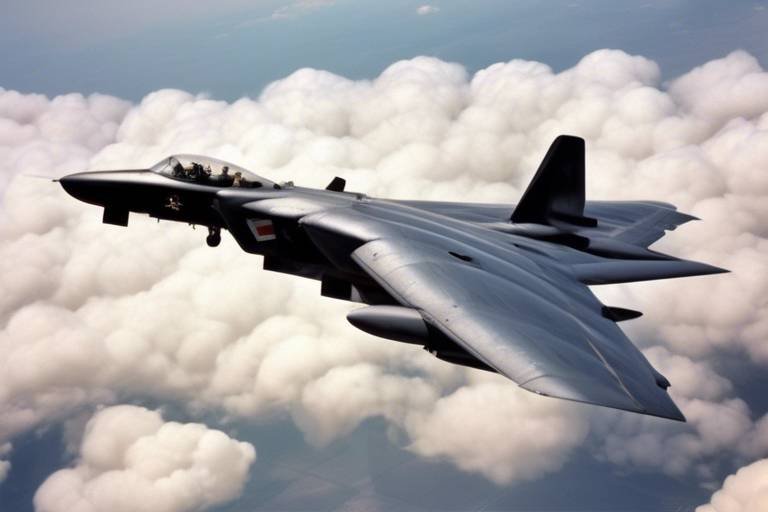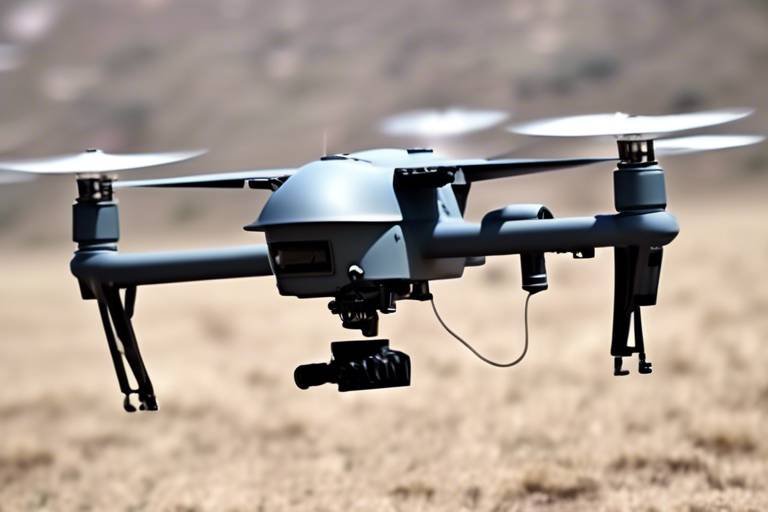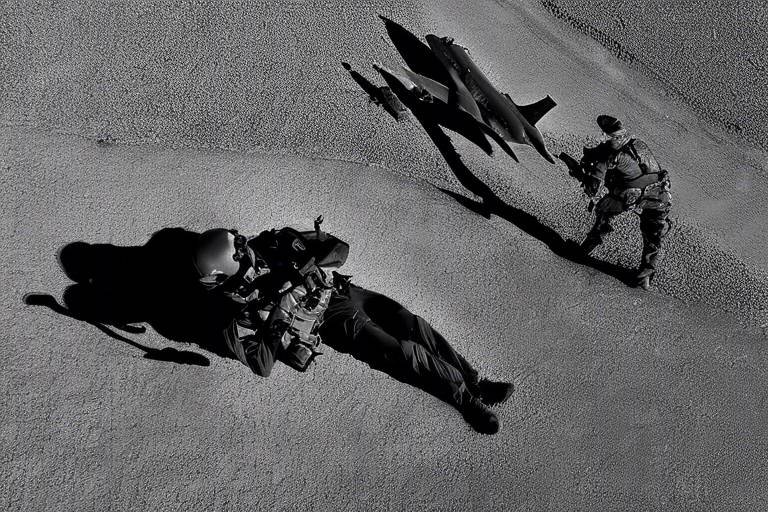Current Uses of the Robotic Combat Vehicle (RCV) in the U.S. Army
The landscape of modern warfare is evolving at a breathtaking pace, and one of the most exciting developments is the introduction of Robotic Combat Vehicles (RCVs). These advanced machines are not just a futuristic concept; they are actively reshaping the battlefield dynamics of the U.S. Army. Imagine a scenario where soldiers can engage in combat without putting themselves in harm's way. This is the reality that RCVs are creating, and their current uses are as diverse as they are impactful.
RCVs are designed to enhance operational efficiency by taking on various roles that traditionally required human presence. From reconnaissance to logistics, these robotic units are proving to be invaluable assets on the battlefield. The U.S. Army has recognized the potential of RCVs to minimize risks to personnel while maximizing mission success. In essence, they serve as the ultimate force multipliers, allowing for a more strategic approach to combat.
One of the primary applications of RCVs is in reconnaissance missions. Equipped with state-of-the-art sensors and surveillance technology, they can traverse hostile environments, gathering crucial intelligence without putting soldiers at risk. The ability to collect real-time data not only enhances situational awareness but also allows commanders to make informed decisions swiftly. Imagine sending a robotic unit into enemy territory to scout for threats—this capability is revolutionizing how the Army approaches intelligence gathering.
RCVs fulfill a multitude of operational roles that contribute to their effectiveness on the battlefield. For instance, they are utilized for logistics support, transporting supplies and equipment to troops in remote locations. This logistical prowess ensures that soldiers have the necessary resources at their fingertips, significantly improving operational efficiency. Furthermore, the ability of RCVs to conduct direct combat engagements means they can actively participate in firefights, using advanced weaponry and automated targeting systems to neutralize threats.
During reconnaissance missions, RCVs utilize advanced sensor technologies that allow them to detect enemy positions and assess environmental conditions. These sensors can include thermal imaging, LIDAR, and GPS systems, which enhance the overall situational awareness for ground forces. This is particularly crucial in combat scenarios where knowledge of the battlefield can mean the difference between victory and defeat.
The integration of cutting-edge sensor technologies enables RCVs to operate effectively in a variety of conditions. For example, thermal sensors can detect heat signatures, making it easier to identify hidden enemy combatants. This level of detail is invaluable for strategic planning and execution.
Many RCVs are designed with stealth features that allow them to operate undetected. This capability is essential for gathering intelligence without alerting the enemy. The quiet operation and low radar signature of these vehicles make them ideal for covert operations, enhancing their effectiveness in sensitive missions.
In addition to reconnaissance, RCVs are increasingly deployed for logistics and supply chain support. They can transport equipment and supplies, ensuring that troops receive timely resupply. This reduces the logistical burden on human personnel and allows them to focus on combat operations.
In combat scenarios, RCVs can engage enemy forces directly. Utilizing advanced weaponry and automated targeting systems, these vehicles can improve the accuracy of strikes while minimizing collateral damage. The use of automated targeting systems enhances the precision of engagements, allowing for effective combat strategies that reduce risks to personnel.
The incorporation of automated targeting systems in RCVs allows for precise engagement of enemy targets. This technology not only improves accuracy but also ensures that friendly forces are less likely to be harmed during operations. The ability to strike with pinpoint precision is a game-changer in modern warfare.
Effective human-robot collaboration is essential for maximizing the operational potential of RCVs. Soldiers need to be able to control and coordinate robotic units seamlessly during missions. This collaboration is crucial for ensuring that RCVs can operate effectively alongside human forces, creating a cohesive unit that can tackle challenges on the battlefield.
As technology continues to advance, so too will the capabilities of Robotic Combat Vehicles. Future developments may include enhanced AI integration, improved mobility, and increased autonomy. These advancements will further transform the role of RCVs in modern warfare, making them an even more critical component of military strategy.
- What are Robotic Combat Vehicles? RCVs are unmanned vehicles designed to perform various military tasks, including reconnaissance, logistics, and combat operations.
- How do RCVs enhance battlefield safety? By taking on dangerous tasks, RCVs reduce the risk to human soldiers, allowing them to focus on other critical missions.
- What technologies do RCVs use? RCVs utilize advanced sensors, automated targeting systems, and stealth capabilities to operate effectively in combat scenarios.

Overview of Robotic Combat Vehicles
Robotic Combat Vehicles (RCVs) are not just a futuristic concept; they are a reality that is reshaping the battlefield as we know it. These remarkable machines represent a significant advancement in military technology, specifically designed to enhance battlefield capabilities through automation and remote operation. Imagine a scenario where soldiers can command a fleet of robots from a safe distance, mitigating the risks associated with direct combat. This is the essence of RCVs, which aim to reduce human exposure to danger while increasing operational effectiveness.
One of the most striking features of RCVs is their versatility. They can be deployed in various roles, from reconnaissance to logistics support and even direct combat. This flexibility allows military commanders to tailor their use based on the specific needs of a mission. For instance, in a reconnaissance role, RCVs equipped with advanced sensors can gather intelligence about enemy positions and terrain without putting soldiers in harm's way. In logistics, they can transport supplies and equipment, ensuring that troops have what they need when they need it.
Furthermore, RCVs are equipped with cutting-edge technologies that enhance their functionality. Their design incorporates autonomous navigation systems, allowing them to traverse difficult terrains and adapt to changing battlefield conditions. This capability is crucial, especially in environments where traditional vehicles might struggle. The integration of artificial intelligence also plays a significant role, enabling RCVs to make real-time decisions based on data collected from their surroundings.
To illustrate the impact of RCVs, consider the following table that highlights some key features and benefits:
| Feature | Benefit |
|---|---|
| Autonomous Navigation | Reduces the need for human drivers, allowing for safer operations in hazardous areas. |
| Advanced Sensors | Enhances situational awareness, providing critical data for decision-making. |
| Remote Operation | Minimizes risks to personnel by allowing operators to control RCVs from a distance. |
| Versatile Applications | Can be used for reconnaissance, logistics, and combat, adapting to various mission requirements. |
In summary, RCVs are a game-changer for the U.S. Army, combining advanced technology with operational flexibility. As these vehicles continue to evolve, they will undoubtedly play an even more critical role in modern warfare, making the battlefield safer for soldiers while enhancing mission success rates.
- What are Robotic Combat Vehicles? RCVs are unmanned vehicles designed for various military operations, including reconnaissance, logistics, and combat, enhancing battlefield capabilities.
- How do RCVs improve soldier safety? By performing dangerous tasks remotely, RCVs reduce the need for soldiers to be in harm's way, thus increasing their safety during missions.
- What technologies are integrated into RCVs? RCVs utilize advanced sensors, autonomous navigation systems, and artificial intelligence to enhance their operational effectiveness.
- Can RCVs operate in difficult terrains? Yes, RCVs are designed to navigate challenging environments, making them suitable for various battlefield conditions.
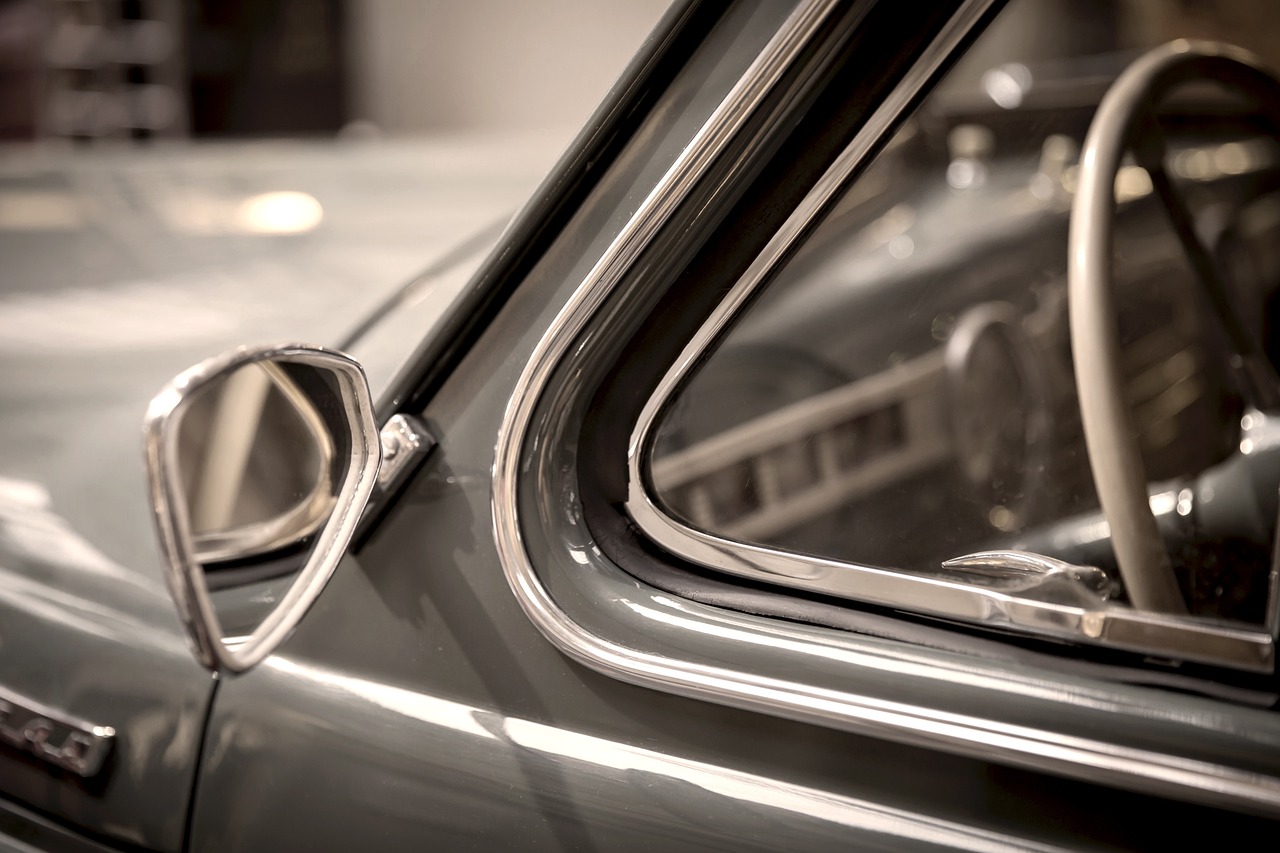
Operational Roles of RCVs
Robotic Combat Vehicles (RCVs) have revolutionized the battlefield, taking on a multitude of operational roles that enhance mission success while minimizing risks to human soldiers. These versatile machines are not just tools; they are integral components of modern military strategy. From reconnaissance to logistics and direct combat, RCVs are reshaping how the U.S. Army conducts operations. Imagine the battlefield as a complex chess game, where each piece has a specific role, and RCVs serve as the advanced knights and bishops, maneuvering strategically to outsmart the enemy.
One of the primary roles of RCVs is in reconnaissance. Deployed in hostile territories, these vehicles utilize advanced sensors and surveillance technology to gather critical intelligence. The ability to collect real-time data without putting soldiers in harm's way is invaluable. For instance, RCVs can traverse difficult terrains and provide commanders with a comprehensive view of the battlefield, allowing for informed decision-making. This is akin to having a pair of binoculars that not only see far but also analyze the landscape, identifying potential threats and opportunities.
In addition to reconnaissance, RCVs play a significant role in logistics and supply chain support. Imagine a scenario where troops are isolated and in need of supplies. RCVs can autonomously transport equipment, ammunition, and medical supplies to frontline units, ensuring that they remain operational. By streamlining logistics, these robotic vehicles help maintain the flow of resources, much like a well-oiled machine that keeps everything running smoothly. This capability not only enhances efficiency but also allows human soldiers to focus on their primary mission rather than worrying about resupply.
Moreover, RCVs are increasingly utilized in combat engagement. Equipped with advanced weaponry and automated targeting systems, they can engage enemy forces directly, providing a tactical advantage. The precision of automated systems reduces collateral damage and increases the likelihood of mission success. This capability is essential in today’s warfare, where the stakes are high, and the margin for error is slim. Picture RCVs as sharpshooters on the battlefield, executing their tasks with pinpoint accuracy and minimal risk to their operators.
As we look towards the future, the operational roles of RCVs are expected to expand further. Innovations in artificial intelligence and machine learning will enhance their capabilities, allowing for greater autonomy and decision-making in complex environments. This evolution will not only change how RCVs are used but will also redefine the very nature of military operations. The synergy between human soldiers and robotic units is akin to a dance, where each partner must understand the other's movements to create a seamless performance on the battlefield.
- What are Robotic Combat Vehicles (RCVs)?
RCVs are unmanned vehicles designed for various military operations, including reconnaissance, logistics, and combat engagement, aimed at enhancing battlefield capabilities. - How do RCVs improve operational efficiency?
By taking on high-risk tasks and streamlining logistics, RCVs allow human soldiers to focus on their primary missions while minimizing exposure to danger. - What technologies do RCVs use for reconnaissance?
RCVs utilize advanced sensors and surveillance systems to gather intelligence and provide real-time data to command units without risking soldier lives. - Can RCVs operate autonomously?
Yes, future developments in AI and machine learning are expected to enhance the autonomy of RCVs, allowing them to make decisions in complex environments.
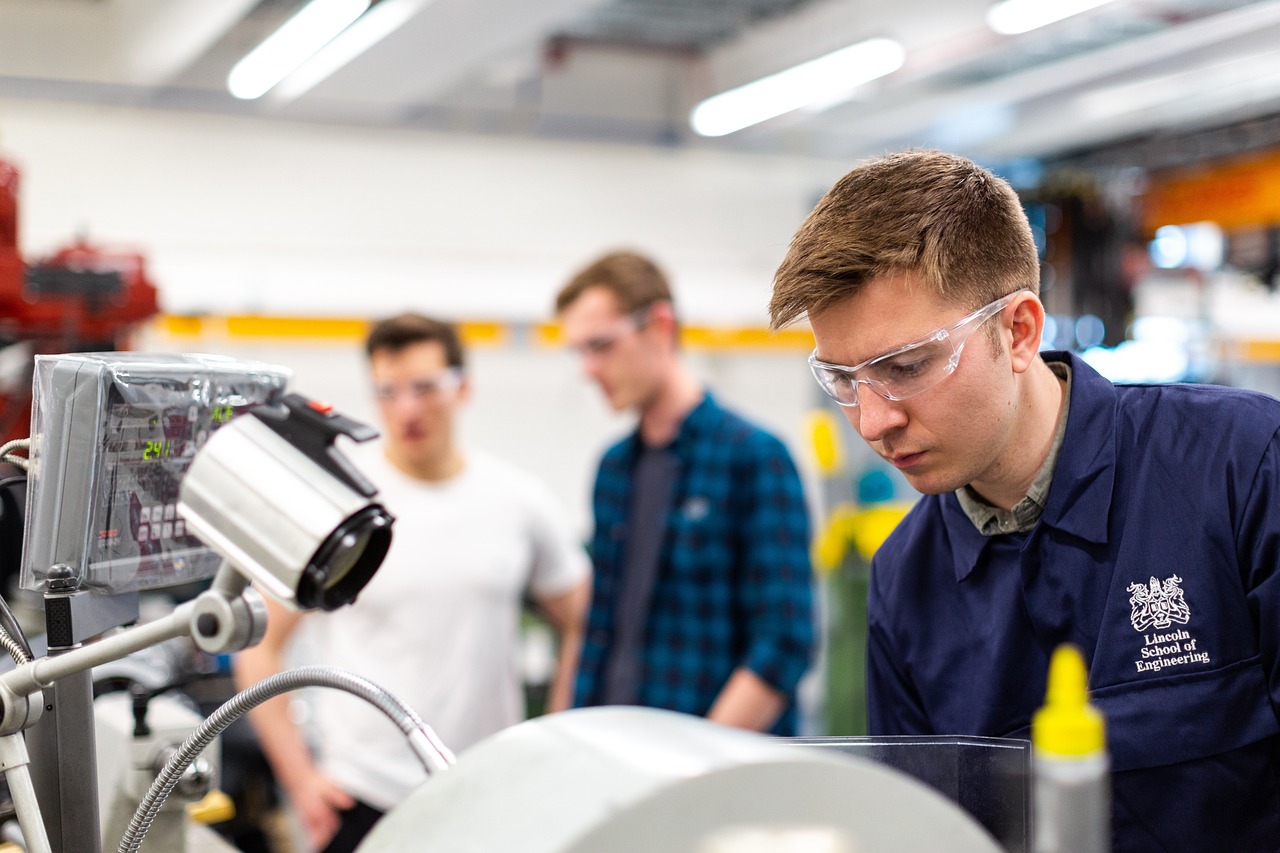
Reconnaissance Missions
In the ever-evolving landscape of modern warfare, have become a crucial component of military strategy, and Robotic Combat Vehicles (RCVs) are at the forefront of this transformation. These advanced machines are equipped with state-of-the-art technology that allows them to perform reconnaissance tasks with unparalleled efficiency and safety. Imagine sending a robot into the heart of enemy territory, gathering vital information without putting a single soldier at risk. This is not science fiction; it's the reality of today's battlefield.
RCVs are designed to operate in diverse environments, from urban settings to rugged terrains, making them versatile tools for intelligence gathering. They utilize a combination of advanced sensors and surveillance technologies to gather data on enemy positions, troop movements, and even environmental conditions. This information is crucial for commanders who rely on real-time intelligence to make informed decisions. Without these robotic assets, the risk to human life would be significantly higher, and the quality of intelligence could be compromised.
One of the standout features of RCVs is their ability to integrate various sensor technologies. For instance, they often come equipped with:
- Infrared cameras for night vision capabilities
- Radar systems to detect movement
- Environmental sensors to assess weather conditions
This multi-faceted approach to intelligence gathering enhances the situational awareness of ground forces, allowing them to adapt their strategies based on the data collected by the RCVs. Moreover, the stealth capabilities of many RCVs enable them to operate undetected, significantly improving their effectiveness in gathering intelligence and executing covert operations. These features help to ensure that RCVs can infiltrate enemy lines without alerting their adversaries, providing a tactical advantage that is hard to replicate with traditional methods.
As we look to the future, the role of RCVs in reconnaissance missions is expected to expand even further. With advancements in artificial intelligence and machine learning, these robotic vehicles will become even more autonomous, capable of making real-time decisions based on the data they collect. This evolution promises to revolutionize how military operations are conducted, making reconnaissance missions not only safer but also more effective.
- What are the primary functions of RCVs in reconnaissance missions?
RCVs are primarily used to gather intelligence, detect enemy positions, and assess environmental conditions without risking human lives. - How do RCVs enhance situational awareness?
By utilizing advanced sensors and real-time data transmission, RCVs provide commanders with critical information that aids in decision-making. - Are RCVs capable of operating in all environments?
Yes, RCVs are designed to function effectively in various terrains, including urban and wilderness settings. - What advancements can we expect in RCV technology?
Future developments may include improved AI integration, enhanced mobility, and greater autonomy in operations.

Sensor Technologies
In the ever-evolving landscape of military operations, play a pivotal role in enhancing the capabilities of Robotic Combat Vehicles (RCVs). These sophisticated systems are not just about brute force; they are about gathering critical information that can turn the tide of battle. Imagine sending a robotic scout into enemy territory, equipped with an array of sensors that can detect everything from troop movements to environmental hazards. This is the reality that modern warfare embraces, and it’s all thanks to advanced sensor technologies.
RCVs are outfitted with a variety of sensors that allow them to perform a multitude of functions. For instance, they may utilize infrared cameras to detect heat signatures, making it possible to identify hidden enemy positions even in complete darkness. Additionally, radar systems can track moving objects, providing real-time data on enemy movements and activities. The integration of these technologies creates a comprehensive surveillance package that enhances the situational awareness of ground forces.
Moreover, the data collected by these sensors is transmitted back to command units in real-time, allowing for instantaneous decision-making. This capability is crucial, especially in fast-paced combat scenarios where every second counts. The ability to assess the battlefield accurately and swiftly can mean the difference between success and failure in military missions.
Another exciting aspect of sensor technologies in RCVs is their ability to monitor environmental conditions. For example, sensors can assess terrain types, weather patterns, and potential hazards, providing invaluable information that influences tactical planning. This feature not only enhances operational efficiency but also minimizes risks to personnel by ensuring they are well-informed before engaging in any mission.
To give you a clearer picture, here’s a brief overview of some key sensor technologies used in RCVs:
| Sensor Type | Function |
|---|---|
| Infrared Cameras | Detects heat signatures for nighttime surveillance |
| Radar Systems | Tracks moving objects and enemy movements |
| LiDAR | Creates detailed 3D maps of the terrain |
| Acoustic Sensors | Detects sounds to identify nearby threats |
With these technologies, RCVs not only enhance their operational capabilities but also redefine the concept of stealth. By utilizing advanced sensor systems, they can operate in a covert manner, gathering intelligence without revealing their presence. This stealth capability is crucial for executing successful reconnaissance missions and ensuring the safety of ground troops.
In conclusion, the integration of sensor technologies in Robotic Combat Vehicles represents a significant leap forward in military operations. By providing real-time data, enhancing situational awareness, and ensuring stealthy operations, these technologies are transforming the battlefield landscape. As we look to the future, the potential for even more advanced sensors is exciting, promising to further enhance the effectiveness and versatility of RCVs in modern warfare.
- What are Robotic Combat Vehicles (RCVs)?
RCVs are unmanned vehicles designed to perform various military tasks, including reconnaissance, logistics support, and direct combat, often operated remotely to minimize risks to personnel. - How do sensor technologies enhance RCV capabilities?
Sensor technologies allow RCVs to gather critical intelligence, monitor environmental conditions, and detect enemy movements, significantly improving situational awareness and operational effectiveness. - What types of sensors are commonly used in RCVs?
Common sensors include infrared cameras, radar systems, LiDAR, and acoustic sensors, each serving specific functions to enhance the vehicle's operational capabilities. - How do RCVs contribute to battlefield stealth?
By employing advanced sensors, RCVs can operate undetected, gathering intelligence and executing missions without revealing their presence to the enemy.

Stealth Capabilities
Stealth capabilities in Robotic Combat Vehicles (RCVs) are a game-changer in modern warfare. Imagine a silent predator that can navigate the battlefield undetected, gathering crucial intelligence while keeping its operators safe. This is precisely what stealth technology offers to RCVs. By minimizing their radar and thermal signatures, these vehicles can operate in enemy territory without drawing attention, providing a significant tactical advantage.
One of the primary features of stealth RCVs is their low observability. This is achieved through specialized materials and design techniques that absorb or deflect radar waves, making them less visible to enemy detection systems. Additionally, many RCVs are equipped with advanced cooling systems that reduce their heat emissions, further complicating detection efforts. These characteristics allow RCVs to conduct reconnaissance missions effectively, enabling them to gather intelligence without putting soldiers at risk.
Moreover, stealth capabilities are not just about avoiding detection; they also enhance the vehicle's operational flexibility. With the ability to operate covertly, RCVs can infiltrate enemy lines, assess enemy positions, and relay vital information back to command units in real-time. This real-time intelligence is crucial for making informed decisions during combat scenarios, allowing ground forces to plan their next moves with greater precision.
To give you a clearer picture, here’s a comparison of traditional combat vehicles versus stealth RCVs:
| Feature | Traditional Combat Vehicles | Stealth RCVs |
|---|---|---|
| Radar Signature | High | Low |
| Thermal Signature | High | Minimized |
| Operational Range | Limited by visibility | Extended due to stealth |
| Risk to Personnel | High | Low |
In summary, the stealth capabilities of RCVs not only protect the lives of soldiers but also enhance their effectiveness in gathering intelligence and executing missions. As technology continues to advance, we can expect even more innovative stealth features in future RCV models, further solidifying their role as essential assets on the battlefield.
- What are Robotic Combat Vehicles (RCVs)?
RCVs are unmanned vehicles designed for various military applications, including reconnaissance, logistics, and combat operations. - How do stealth capabilities benefit RCVs?
Stealth capabilities allow RCVs to operate undetected, gathering intelligence and conducting missions without exposing personnel to danger. - What technologies are used to achieve stealth in RCVs?
Stealth in RCVs is achieved through advanced materials that reduce radar visibility and cooling systems that minimize heat emissions. - Can RCVs engage in combat?
Yes, RCVs can engage enemy forces directly using automated targeting systems, enhancing operational effectiveness while reducing risks to personnel.
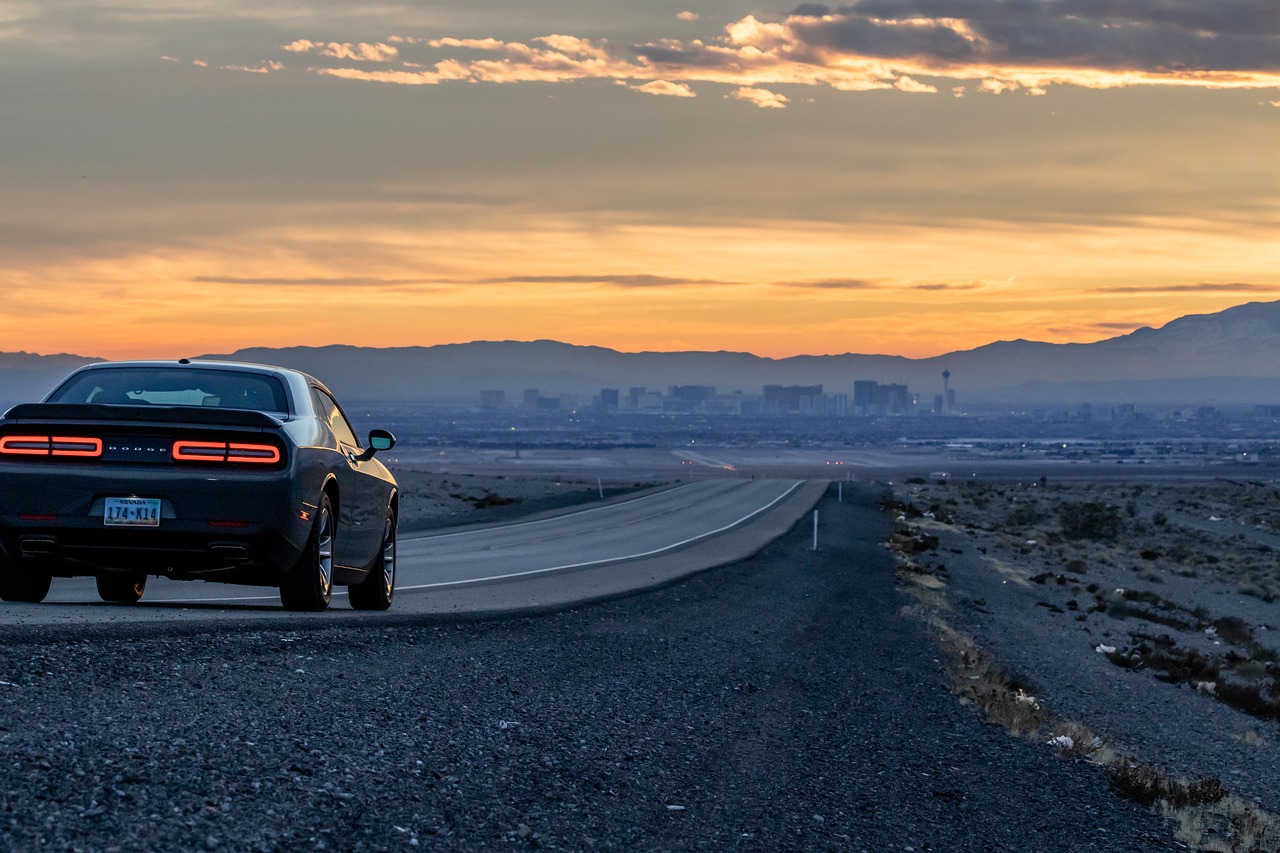
Logistics and Supply Chain Support
In the fast-paced world of modern warfare, logistics and supply chain management are crucial for mission success. The introduction of Robotic Combat Vehicles (RCVs) has revolutionized how the U.S. Army approaches these challenges. Imagine a battlefield where supplies and equipment can be delivered to troops without putting human lives at risk. That's exactly what RCVs are doing. These advanced vehicles are designed to transport everything from ammunition to medical supplies, ensuring that soldiers have what they need when they need it.
One of the standout features of RCVs in logistics is their ability to operate in hostile environments. When conventional supply routes are compromised or too dangerous, RCVs can navigate through challenging terrains, delivering essential supplies while minimizing the risk to personnel. This capability not only enhances the efficiency of military operations but also allows for a more agile response to changing battlefield conditions.
Furthermore, RCVs can be equipped with autonomous navigation systems, enabling them to travel predetermined routes or adapt to unexpected obstacles. This level of automation not only speeds up the supply chain but also reduces the burden on human operators. With real-time data transmission capabilities, RCVs can communicate their status and location back to command units, providing a clearer picture of supply levels and needs on the ground.
To illustrate the impact of RCVs on logistics, consider the following table that showcases the advantages of using these robotic systems:
| Feature | Benefit |
|---|---|
| Autonomous Navigation | Reduces the need for human drivers in dangerous areas. |
| Real-time Data Transmission | Enhances situational awareness and supply chain transparency. |
| Payload Capacity | Can carry significant amounts of supplies, increasing resupply efficiency. |
| Operational Flexibility | Can adapt to various terrains and conditions, ensuring reliable delivery. |
Moreover, RCVs play a pivotal role in reducing the logistical footprint of military operations. By utilizing these vehicles, the Army can decrease the number of personnel required for supply missions, allowing them to focus on frontline duties. This not only enhances safety but also optimizes resource allocation. In essence, RCVs are not just vehicles; they are force multipliers that streamline operations and enhance overall mission effectiveness.
As we look to the future, the potential for RCVs in logistics is immense. With advancements in technology, we can expect even greater levels of automation and intelligence, further transforming how the Army manages its supply chains. The integration of AI and machine learning could lead to RCVs that can predict supply needs based on real-time battlefield data, ensuring that troops are always equipped to face the challenges ahead.
- What are Robotic Combat Vehicles? RCVs are unmanned vehicles designed to support military operations through various roles, including logistics, reconnaissance, and combat.
- How do RCVs improve logistics in the Army? They enhance supply chain efficiency by delivering supplies autonomously, reducing risks to personnel, and providing real-time data on supply levels.
- Can RCVs operate in hostile environments? Yes, RCVs are designed to navigate challenging terrains and operate in dangerous areas where traditional supply routes may be compromised.
- What future advancements can we expect in RCV technology? Future developments may include enhanced AI integration, improved mobility, and increased autonomy, further transforming their role in military logistics.
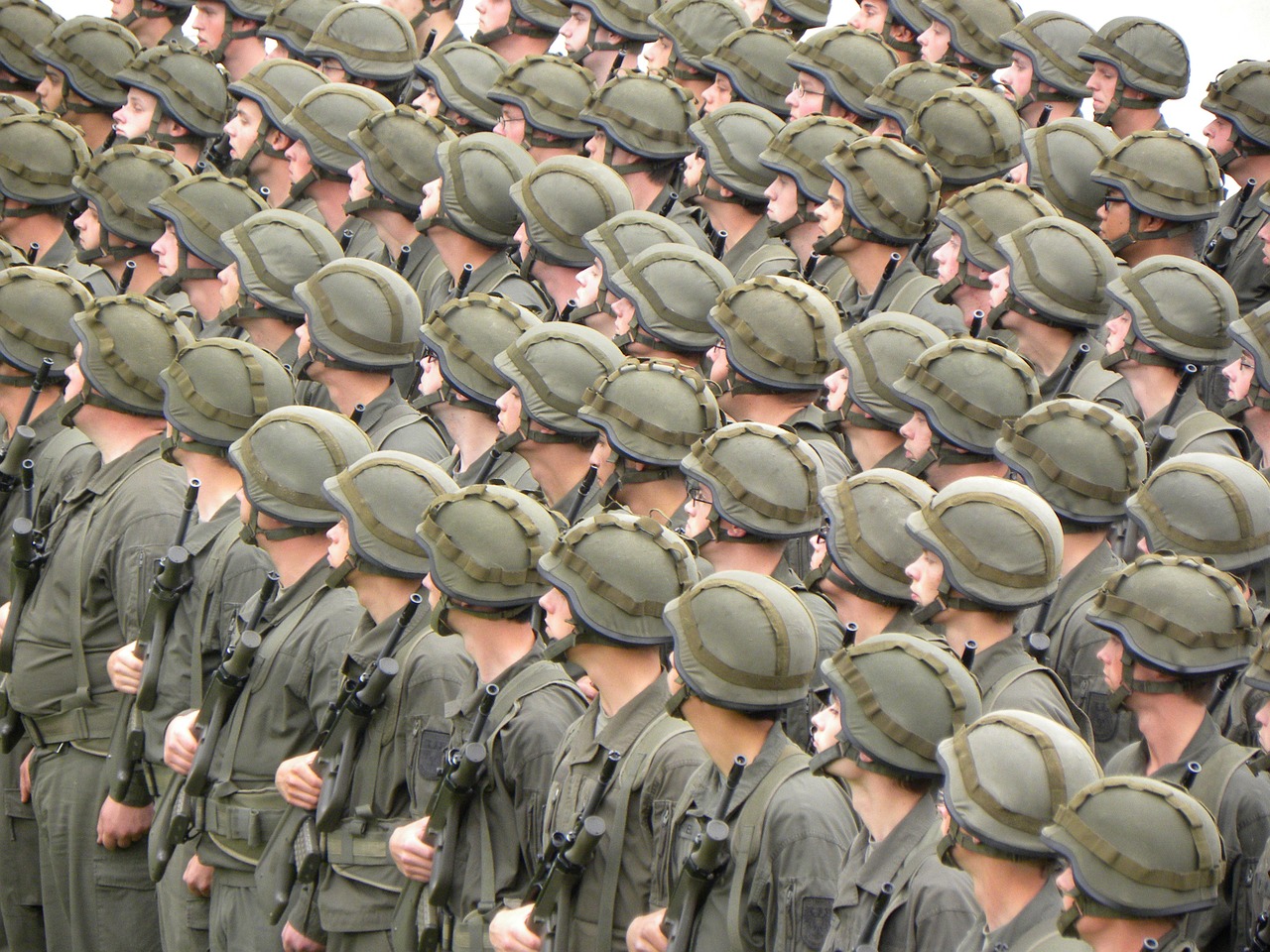
Combat Engagement Strategies
In the ever-evolving landscape of modern warfare, utilizing Robotic Combat Vehicles (RCVs) are becoming increasingly sophisticated. These vehicles are not just remote-controlled machines; they are equipped with advanced technologies that allow them to engage enemy forces in ways that were once the realm of science fiction. Imagine a battlefield where soldiers can orchestrate operations from a safe distance, using RCVs to do the heavy lifting, so to speak. This shift in combat dynamics greatly enhances operational effectiveness while minimizing risks to personnel.
One of the most notable advancements in RCVs is their automated targeting systems. These systems leverage cutting-edge algorithms and sensor data to identify and engage enemy targets with remarkable precision. The ability to reduce collateral damage is crucial in modern combat scenarios, where the stakes are high, and the consequences of error can be catastrophic. By utilizing automated targeting, RCVs can make split-second decisions, allowing for rapid engagement of threats while maintaining a high level of accuracy. This capability not only improves mission success rates but also ensures the safety of nearby civilian populations and allied forces.
Moreover, the integration of human-robot collaboration plays a pivotal role in maximizing the effectiveness of RCVs. While these vehicles are capable of operating autonomously, the human element remains essential. Soldiers on the ground can control and coordinate RCVs in real-time, allowing for a seamless integration of robotic units into traditional combat strategies. This collaboration is akin to a conductor leading an orchestra; the conductor (the soldier) guides the musicians (the RCVs) to create a harmonious output that can adapt to the chaotic nature of the battlefield.
To illustrate the various combat engagement strategies involving RCVs, consider the following table:
| Strategy | Description | Benefits |
|---|---|---|
| Direct Engagement | RCVs engage enemy forces directly using onboard weaponry. | Reduces risk to personnel, increases firepower. |
| Support Operations | RCVs provide covering fire or suppress enemy positions. | Enhances tactical advantage, protects ground troops. |
| Intelligence Gathering | RCVs gather intelligence while remaining undetected. | Improves situational awareness, informs strategic decisions. |
As we look to the future, the potential for RCVs in combat engagement strategies is vast. With advancements in artificial intelligence and machine learning, RCVs may soon be able to make independent tactical decisions based on real-time data. This evolution could lead to a new era of warfare where robotic units operate in concert with human soldiers, creating a synergistic effect that enhances overall mission effectiveness.
In conclusion, the combat engagement strategies involving Robotic Combat Vehicles are not just about technology; they represent a fundamental shift in how military operations are conducted. By leveraging the strengths of RCVs, the U.S. Army can enhance its operational capabilities, ensuring that its forces remain agile, effective, and safe in the face of ever-changing threats.
- What are Robotic Combat Vehicles (RCVs)?
RCVs are unmanned vehicles designed for various military applications, including reconnaissance, logistics, and direct combat. - How do automated targeting systems work?
These systems use advanced algorithms and sensor data to identify and engage targets with high precision, reducing collateral damage. - What role does human-robot collaboration play in RCV operations?
Human operators can control and coordinate RCVs in real-time, enhancing the effectiveness of military strategies while ensuring safety. - What are the future prospects for RCV technology?
Future advancements may include enhanced AI integration, improved mobility, and increased autonomy, transforming their role in warfare.
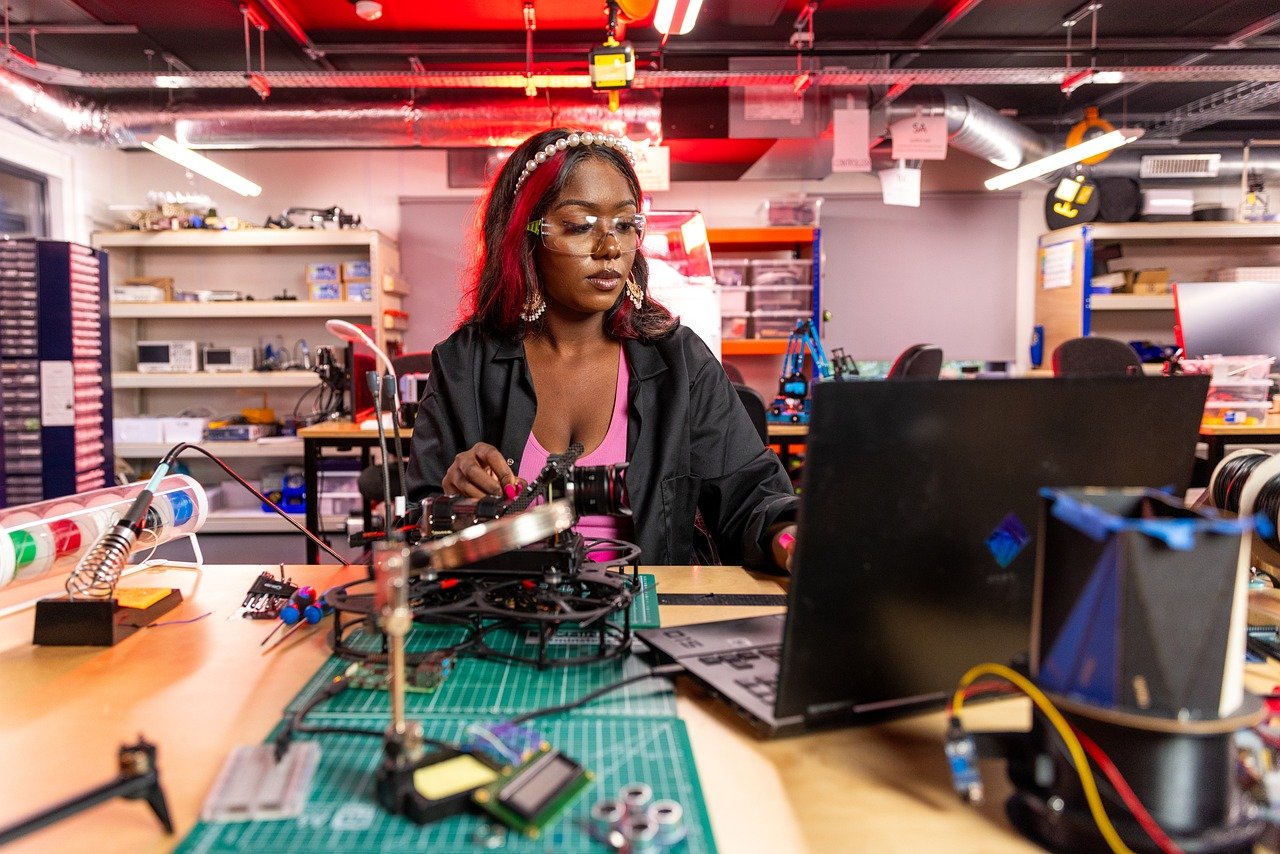
Automated Targeting Systems
The advent of (ATS) in Robotic Combat Vehicles (RCVs) marks a revolutionary shift in military engagement strategies. Imagine a battlefield where precision is paramount, and the fog of war is lifted by technology that can identify and engage targets with unparalleled accuracy. This is not just a futuristic dream; it is the reality that RCVs bring to modern warfare. The integration of ATS allows these robotic units to assess threats in real-time, enabling them to make split-second decisions that can save lives and resources.
One of the standout features of ATS is their ability to analyze vast amounts of data quickly. These systems utilize algorithms that process information from various sources, including visual sensors, infrared cameras, and radar systems. By synthesizing this information, RCVs can create a comprehensive picture of the battlefield, identifying enemy positions and potential threats before human operators even have a chance to react. This capability not only enhances the effectiveness of military operations but also significantly reduces the risk of collateral damage.
For example, imagine a scenario where an RCV is deployed in a hostile environment. As it maneuvers through the terrain, its ATS detects movement in a nearby structure. Instead of blindly engaging the target, the system analyzes the data to determine whether the movement is a combatant or a civilian. This level of discernment is crucial in modern warfare, where the lines between combatants and non-combatants can often blur.
Moreover, the precision of these systems is further enhanced by the use of machine learning. As RCVs operate in various environments, they continuously learn from their experiences, improving their targeting algorithms over time. This self-learning capability ensures that RCVs become more effective with each mission, adapting to new tactics and enemy behaviors. The result is a more agile and responsive combat unit that can operate effectively in dynamic situations.
However, the implementation of Automated Targeting Systems is not without challenges. Ethical considerations arise when machines make life-and-death decisions. The question of accountability in the event of an error is a hot topic among military strategists and ethicists alike. As technology advances, it is essential to establish clear guidelines and protocols to govern the use of ATS, ensuring that human oversight remains a critical component of military operations.
In summary, Automated Targeting Systems represent a leap forward in the capabilities of Robotic Combat Vehicles. By enhancing precision, reducing collateral damage, and adapting to dynamic battlefield conditions, these systems are transforming how military engagements are conducted. As we move forward, the balance between technological advancement and ethical responsibility will be crucial in shaping the future of warfare.
- What are Automated Targeting Systems?
Automated Targeting Systems are advanced technologies integrated into Robotic Combat Vehicles that enable them to identify and engage enemy targets with high precision. - How do ATS improve military operations?
ATS enhance military operations by providing real-time data analysis, reducing the risk of collateral damage, and allowing for quicker decision-making in combat scenarios. - What ethical concerns are associated with ATS?
Ethical concerns include accountability for decisions made by machines and ensuring that human oversight is maintained to prevent unintended consequences. - Can RCVs learn from their experiences?
Yes, RCVs equipped with machine learning capabilities can adapt their targeting algorithms based on past experiences, improving their effectiveness over time.

Human-Robot Collaboration
In the rapidly evolving landscape of military operations, is becoming a game-changer. Imagine a battlefield where soldiers and robotic combat vehicles (RCVs) work side by side, enhancing each other's strengths while compensating for weaknesses. This synergy is not just a futuristic dream; it's happening right now. As RCVs become more integrated into military strategies, the need for effective collaboration between humans and machines is paramount.
One of the key aspects of successful human-robot collaboration lies in the user interface. RCVs are equipped with sophisticated control systems that allow operators to manage these vehicles from a distance. This capability enables soldiers to maintain situational awareness while keeping themselves out of harm's way. For example, a soldier can control an RCV equipped with advanced sensors to scout enemy positions without exposing themselves to potential threats. This not only enhances safety but also increases the likelihood of mission success.
Furthermore, training plays a crucial role in ensuring that soldiers can effectively collaborate with RCVs. Military training programs are evolving to include simulations and exercises that focus on human-robot teamwork. Soldiers learn how to interpret data from RCVs, make quick decisions based on real-time information, and coordinate actions seamlessly. This training is akin to teaching a musician to play in harmony with a digital instrument—it's all about creating a rhythm that maximizes performance.
Moreover, the communication between human operators and RCVs is essential for effective collaboration. Advanced algorithms and AI are being developed to facilitate this interaction. For instance, RCVs can analyze battlefield conditions and suggest tactical options to their human counterparts. This level of interaction transforms the battlefield into a more dynamic environment where decisions can be made swiftly and accurately.
As we look to the future, the potential of human-robot collaboration in military operations is limitless. With advancements in AI and machine learning, RCVs will become even more autonomous and capable of understanding complex scenarios. It’s not just about having robots that follow orders; it's about creating a partnership where both humans and machines can learn from each other, adapt, and evolve. This could lead to a new era of warfare where the combination of human intuition and robotic precision creates unparalleled operational effectiveness.
- What is human-robot collaboration in military operations?
Human-robot collaboration involves soldiers working alongside robotic systems, such as RCVs, to enhance mission effectiveness and safety. - How do RCVs communicate with human operators?
RCVs utilize advanced control systems and AI algorithms to communicate critical data and suggestions to their human counterparts. - What training is required for soldiers to operate RCVs?
Soldiers undergo specialized training that includes simulations and exercises focused on understanding RCV capabilities and effective teamwork. - What are the future prospects of human-robot collaboration?
Future advancements may lead to more autonomous RCVs that can learn from human operators, creating a more effective partnership on the battlefield.

Future Developments in RCV Technology
The future of Robotic Combat Vehicles (RCVs) is not just a glimpse of what could be; it’s a thrilling evolution that promises to reshape the battlefield. As technology advances at an unprecedented pace, the capabilities of RCVs are set to expand dramatically. Imagine a world where these machines operate with enhanced artificial intelligence (AI), making decisions in real-time and adapting to dynamic combat environments. This isn't just science fiction; it's on the horizon.
One of the most exciting prospects is the integration of advanced AI algorithms that allow RCVs to learn from their surroundings. Picture an RCV that can analyze enemy movements, predict their strategies, and autonomously adjust its tactics. This level of sophistication could significantly reduce the need for human intervention, allowing soldiers to focus on higher-level decision-making while the RCVs handle the grunt work.
Moreover, we can expect improvements in mobility. Future RCVs may feature enhanced mobility systems that enable them to traverse challenging terrains, whether it's rocky mountains, dense forests, or urban landscapes. Imagine an RCV that can seamlessly transition from driving on a highway to navigating through narrow alleyways, all while maintaining operational efficiency. This versatility will not only enhance their effectiveness but also provide crucial support in various combat scenarios.
Another key development is the potential for increased autonomy. Future RCVs could operate independently for extended periods, conducting reconnaissance and supply missions without constant human oversight. This autonomy would be particularly beneficial in high-risk areas, where sending in human troops could lead to unnecessary casualties. By allowing RCVs to take the lead in dangerous situations, the U.S. Army can protect its personnel while still achieving mission objectives.
Furthermore, the integration of collaborative robotic systems will revolutionize how RCVs interact with human soldiers. Imagine a squad of RCVs working in unison, each equipped with specialized functions, yet communicating seamlessly with one another and their human counterparts. This level of collaboration will enhance operational efficiency and effectiveness, enabling the military to execute complex missions with precision.
To illustrate the potential advancements, consider the following table that outlines some of the expected future developments in RCV technology:
| Development Area | Expected Advancements |
|---|---|
| Artificial Intelligence | Real-time decision-making and adaptive learning capabilities |
| Mobility | Enhanced terrain navigation and obstacle avoidance |
| Autonomy | Extended independent operations and mission execution |
| Collaboration | Seamless interaction between RCVs and human soldiers |
As we look to the future, it’s clear that the evolution of RCV technology will continue to push the boundaries of what is possible in military operations. The combination of AI, improved mobility, and enhanced autonomy will not only transform the role of RCVs but also redefine modern warfare. The U.S. Army is on the brink of a technological revolution that will enhance operational effectiveness while keeping our soldiers safer than ever before.
- What are Robotic Combat Vehicles (RCVs)? RCVs are unmanned military vehicles designed to perform various tasks on the battlefield, including reconnaissance, logistics, and combat operations.
- How do RCVs enhance operational safety? By operating remotely or autonomously, RCVs reduce the risk to human soldiers in high-threat environments.
- What advancements can we expect in RCV technology? Future developments may include enhanced AI, improved mobility, increased autonomy, and better collaboration with human soldiers.
- Are RCVs currently in use by the U.S. Army? Yes, RCVs are currently being tested and deployed in various capacities to support military operations.
Frequently Asked Questions
- What are Robotic Combat Vehicles (RCVs)?
Robotic Combat Vehicles (RCVs) are advanced military machines designed to enhance battlefield capabilities through automation and remote operation. They help reduce risks to personnel while increasing operational effectiveness in various roles, including reconnaissance, logistics, and direct combat.
- How do RCVs improve reconnaissance missions?
RCVs utilize advanced sensors and surveillance technology to gather critical intelligence without putting soldiers at risk. By providing real-time data to command units, they significantly enhance situational awareness and enable better decision-making on the battlefield.
- What types of sensor technologies are integrated into RCVs?
RCVs are equipped with cutting-edge sensor technologies that allow them to detect enemy positions, assess terrain, and monitor environmental conditions. This integration enhances the effectiveness of ground forces and improves overall mission success.
- Do RCVs have stealth capabilities?
Yes, many RCVs are designed with stealth features that enable them to operate undetected. This capability is crucial for gathering intelligence and executing covert operations without alerting enemy forces.
- How do RCVs support logistics and supply chain operations?
RCVs streamline logistics by transporting equipment and supplies directly to troops in the field. This ensures timely resupply and enhances operational efficiency, allowing soldiers to focus on their missions without worrying about logistics.
- Can RCVs engage in combat?
Absolutely! RCVs can engage enemy forces directly using advanced weaponry and automated targeting systems. This not only improves accuracy but also helps reduce risks to personnel during combat operations.
- What role do automated targeting systems play in RCVs?
Automated targeting systems in RCVs allow for precise engagement of enemy targets. This technology enhances the effectiveness of military operations by improving accuracy and minimizing collateral damage.
- How is human-robot collaboration managed during missions?
Effective human-robot collaboration is vital for maximizing the operational potential of RCVs. Soldiers are trained to control and coordinate robotic units, ensuring seamless integration and enhanced mission success.
- What future advancements can we expect in RCV technology?
Future developments in RCV technology may include enhanced AI integration, improved mobility, and increased autonomy. These advancements will continue to transform the role of RCVs in modern warfare and expand their capabilities on the battlefield.

